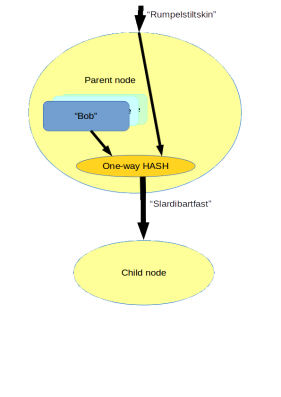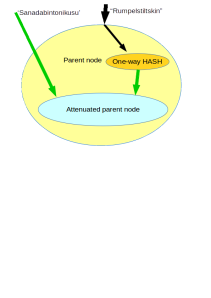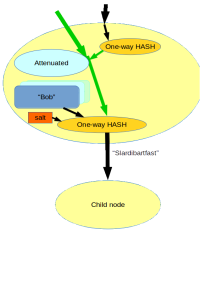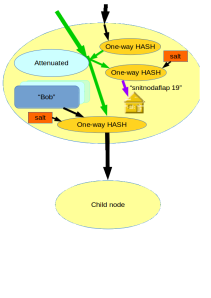In this post, I tried to explain the Rumpelstiltskin tree-graph algorithm. Apparently in the second part of my explanation, the part explaining the actual algorithm, I ‘ve ended up skipping a few steps that were apparently essential for understanding what the algorithm is supposed to do, and how it relates to the directional tree. So in this follow-up I’ll try to fill up the holes I left in my previous post.
So lets start off with the directional tree graph from my previous post:
The first thing that is important here is that each node in this graph has both a strong name (a password capability) and a weak name (a name that carries no authority by itself. The arcs between the nodes above are the strong names.
Now consider that each node has knowledge only of its own strong name and of the weak names of its children. If we were only concerned with maintaining the unidirectionality of our tree graph, than the following image would allow us to derive a child strong name knowing the parent’s strong name and the child’s weak name:
So if we have the strong parent name ‘Rumpelstiltskin’ and the weak child name ‘Bob’, we could use some kind of one way function to determine the strong name of that child. In this case ‘Slardibartfast’. Having the name ‘Rumpelstiltskin’ thus implies authorty to the parent node and all of its children, but the name ‘Slardibartfast’ impies no knowledge or authority over regarding the parent node.
Next to decomposition, there is an other aspect we are interested in: attenuation. If attenuation was the only aspect we were interested in, than an other use of a one way hash function would be usable:
In this picture, our node comes with two strong names. The first name gives unattenuated authority to the node. Using a one way hash function we create a second strong name for the same node. This second name implies attenuated access to the node, In the case of a file-system, this second strong name could be a read-only capability to a file or directory.
Now comes the interesting part: we want to combine the concept of decomposition with the concept of attenuation in a single algorithm in such a way that, and this is the essential quality of the Rumpelstiltskin tree-graph algorithm: “attenuated decomposition results in the same strong name as would decomposed attenuation”.
On a first glance it would seem that we’ve just combined the two diagrams, but there is an essential addition: the use of a secret salt. Again like in the attenuation only diagram, we use a one way hash to create a strong name for attenuated access, but instead of using the unattenuated strong name to determine the unattenuated strong name for the child, we now use the strong name that implies attenuated access to the parent node to create a strong name that implies unattenuated access to the child node. Without the secret salt, doing so would imply that someone with attenuated authority to the parent could unduly gain unattenuated access to the child. By introducing the secret salt to the second hash operation, we allow the parent node to act as proxy for all decomposition operations. That is, the parent node would need to:
- Allow decomposing unattenuated authority to a parent to strong names implying unattenuated authority to the child.
- Allow decomposing attenuated authority to a parent to strong names implying attenuated authority to the child.
- NOT allow decomposing attenuated authority to a parent to strong names implying unattenuated authority to the child.
The fact that the holder of the strong name does not have access to the secret salt ensures that these properties can be guaranteed by the algorithm.Looking at the above diagram, its easy to see that attenuation of decomposition and decomposition of attenuation lead to exactly the same strong names. In order to do so we had to introduce a (server side) secret salt in order to disallow unintended privilege escalation.
We’re almost there, but there is still one more step to consider. Getting back to our imp, we must consider ‘where does our imp live? Or for a file-system, where is the serialisation of this node actually stored, and how is it stored? Lets look at the case of a file-system. Lets consider the nodes are serialized to a file-system that is supplied by some cloud storage provider that we do not fully trust. We would want to encrypt the file. Given that the node may be accessed with any of the two strong names, we can’t use the unattenuated access capability here, but we could use the strong name that implies attenuated authority as an encryption key. Doing so however implies we should never disclose either of our strong names to the cloud storage provider. As you may expect by now, again the one-way hash operation comes to the rescue. We use a third one time hash operation to calculate the relative path where the encrypted node serialisation is to be stored. If we want to consider the scenario that there are entities that posses attenuated access strong names and also posess write access to our cloud storage directories, than we could again add a secret salt to this third hash operation, but in most cases it would seem that salting would not be needed for the third hash operation.
I hope that this follow up blog post helps in the wider comprehension of what I think is a very interesting algorithm for creating attenuatable decomposable unidirectional tree graphs using password-capabilities/strong-names.






You must be logged in to post a comment.